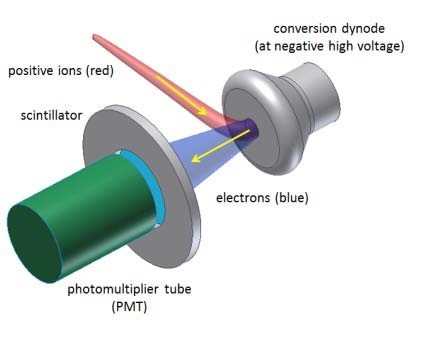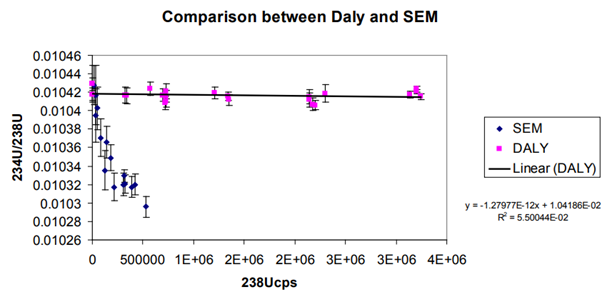If you work in analytical science, and particularly if you’re in spectroscopy or spectrometry, you’ll be aware that there are a number of detector types used. For isotope ratio instruments, it’s common to have multiple detectors in an instrument, usually used to measure ion beam intensities simultaneously rather than sequentially.
In our business, detectors are broadly divided into two types. Firstly, there are those that measure an ion beam voltage (or current), with software translating that voltage into an averaged number of ions for a unit time duration. Faraday detectors are the most common detector of this type. They are used extensively and are cheap, robust and long-lasting. For example, here at Isotopx we guarantee our Faradays for ten years but we typically find that they last much longer than this.
The other detector types are “ion counting” detectors. These measure the impact of each individual ion and consequently can be used for much smaller ion beams than Faraday detectors can.
There are quite a few types of ion counting detectors, using a variety of technologies. One common type is the Secondary Electron Multiplier (SEM) or just “electron multiplier”. A discussion of the SEM and other ion counting techniques is beyond the scope of this post, here we’ll focus on just the Daly type detector.
If you have comments, thoughts, or corrections, do please feel free to contact me directly, I’d love to hear from you (stephen.guilfoyle@isotopx.com).
The Daly detector was designed by N.R Daly in the 1960’s. The design uses a conversion dynode to convert incident ions into electrons. It also separates the multiplication electronics away from the ion beam, preventing secondary ion production on the multiplication dynodes.

The conversion surface is a highly polished, aluminised metal surface (labelled conversion dynode in the image) that is biased at a very high voltage, typically 25KV or more. The bias voltage controls the peak shape and to some extent the transmission. However, the efficiency variation is very small above about 20KV. Ions impact onto the Daly conversion dynode which in turn releases electrons.
These are repelled onto a scintillator forming photons. The photons are detected by a photomultiplier which is external to vacuum. This is radically different to an electron multiplier where the active surface of the multiplier is in the line of sight of the ion beam and the multiplication stages are all in vacuum. This has significant effects on longevity, as we’ll discuss below. So, we know the Daly detector is different to an electron multiplier, but why should you use one? Let’s explore…
Ion counting detectors of all kinds are used to measure extremely small ion currents – typically between 1e-19 and 1e-13 amps. For applications that involve large differences in isotopic abundances such as uranium or radiogenic lead, or indeed for zircon geochronology where the Pb contents of individual zircons is extremely variable, it is crucial that ion-counting detectors have a linear response.
Non-linearity of ion-counters is due to a combination of factors which have been discussed at length in the literature (e.g. Richter et. al 2001). Potentially the largest source of error is the calibration of the deadtime (DT). The deadtime is the period after a count has been registered before another ion can be counted and ideally it should be constant irrespective of count rate.
Typically, the DT is a few tens of nanoseconds but it must be measured accurately to minimize its affects at high count rates. For example, a count rate of 1e6 cps equates to a time between counts of 1 microsecond and a 10ns deadtime would be a 1% contribution. Richter et. al. have shown that at count rates greater than ~20,000 cps, SEM’s are non-linear even after DT correction. The non-linearity becomes larger at higher count rates and can be as high as 1% at 6e5 cps. That’s a significant error in your measurement. So, what about the Daly detector?
In fact, the Daly detector offers a number of advantages over SEM type ion-counters. It has a large dynamic range, providing several orders of magnitude overlap with the Faraday collectors. It also has the highest gain stability relative to the Faraday collectors, and the largest working peak flat. The Daly is much more robust than an SEM. A large beam on an SEM detector can damage it beyond use, even if only exposed briefly, where the Daly detector will not be affected. The photomultiplier is outside of the vacuum housing, so if that’s damaged it is easily replaced without venting the mass spectrometer.
Daly systems have been in continuous operation for over twenty years without replacement of any component. In contrast, SEM’s usually need changing every few years at best, involving a full vent of the instrument, and require regular re-calibration. Once set up, Daly detectors tend to be much easier to use day-to-day.
And what about that linearity? For the Daly detector it’s demonstrably far better than the linearity delivered by electron multipliers.

The image above demonstrates this really well. It’s an image taken directly from a publication by Richter et al (2001, full reference below). It shows a comparison of linearity between a Daly detector and SEM detector for U234/U238 measurement. It’s clear that the Daly data shows excellent linearity, with the SEM data showing very poor linearity at these medium to high count rates. I already mentioned that SEM linearity performance deteriorates at about 20,000 cps and above, severely limiting its use, and you can clearly see this in the image.
What are consequences of this for the user? It results in ever-decreasing gains, the need to keep adjusting the bias voltage to compensate, and the degradation of noise performance that accompanies this. None of these issues affect the Daly.
And what does this mean for your measurement? It should be clear that with the measurement made on the Daly you’ll observe far better accuracy and precision, particularly at the higher count rates where SEM linearity tails off.
So is the Daly detector perfect? Obviously not! Firstly, they are more expensive to buy than an SEM detector. That said, the lifetime cost of the Daly is typically lower once you factor in the cost to buy and fit replacement SEM detectors. They’re also physically larger, so it’s usually prudent to use just one in your mass spectrometer. At Isotopx we have several decades of using these detectors and we also know that the manufacture and polishing of the conversion dynode is very important. We take great pains to get this right. If these factors are not quite right, the background count rate will be much higher – something that the unscrupulous can mask by adjusting the discriminator.
Should you choose a Daly detector then? It’s absolutely the “gold standard” for ion counting detection where high precision measurement of small samples / low abundance isotopes is required. If this sounds like your measurements, then you should choose to use one, there’s no better alternative. If you want to read more about the performance of the Daly there is a link to an application note below. And as always, thanks for reading.
Reference: S. Richter. Goldberg,S.A, Mason, P.B., Traina, A.J. Schweiters, J.B. 2001. Linearity tests for secondary electron multipliers used in isotope ratio mass spectrometry. International. Journal of Mass Spectrometry. 206. 105-127
